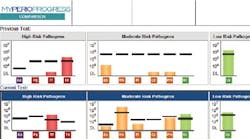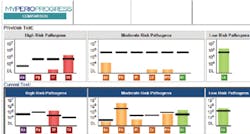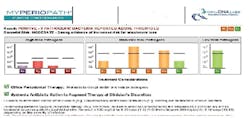Oral-Systemic Health
Is it time to use salivary diagnostic tests for at-risk patients?
By Jannette Whisenhunt, RDH, BS, MEd, PhD
For the past several months, my articles have discussed the oral-systemic link and how periodontal disease may cause more problems for patients with heart disease, diabetes, and other inflammatory diseases. In many of those articles, I have discussed salivary diagnostics. This month, I am getting help from Erika Spring, BSDH, MEd, a friend and educator who knows a great deal about salivary diagnostics, so that you can see how useful and easy it is to incorporate this kind of testing into your office’s perio treatment. Erika is the founder of Spring Innovative Dental Hygiene Consulting and a dental hygiene instructor at Coastal Carolina Community College in Jacksonville, N.C.
We can identify patients who would benefit from a salivary diagnostic test by thinking about the chronic inflammatory process. Patients who would benefit include those who have heart disease, diabetes, autoimmune diseases, or even those with gastric ulcers, as well as patients who are pregnant and patients who have had strokes.1 These medically compromised patients, along with those who have advanced periodontal disease, would be high-risk patients who would benefit from this extra test, which can be easily incorporated into treatment. A patient who isn’t showing progress with normal treatments may show some progress after you determine the exact bacteria you are dealing with.
In accordance with the dental hygiene process of care,2 assessment is a critical step. Our first step in assessment is full periodontal charting.
Case Example No. 1: A baseline test and retest of a middle-aged male with genetic, cardiovascular, and high blood pressure risk factors. Notice the shift in bacteria over a six-year period.
Case Example No. 2: Diabetic patient, 4–5 mm pockets with bleeding on probing. It has “been years” since last cleaning. Diabetics are known to heal slower and be more susceptible to infection; active periodontal disease can affect blood glucose. After the salivary testing results, this patient reported that his daily blood glucose numbers drastically reduced after four quads of periodontal therapy and the recommended antibiotic regime. For more information about OralDNA Labs, visit oraldna.com.
“My normal routine consists of taking a full-mouth series of radiographs, full perio charting, and finally intraoral photos,” said Erika. “This has worked well for me because I utilize each of these items to show patients their own diagnostics. The intraoral photos are particularly helpful as it helps them see the reality of their disease. By the time I have gathered this information along with their medical history, I feel confident in whether or not bacterial testing may be indicated.”
Full-mouth periodontal charting can be beneficial for the patient and for case acceptance. All probing depths should be recorded (yes, even ones, twos, and threes!), as well as bleeding sites, recession, furcations, and mobility. Full-mouth charting can be challenging for some—mostly due to time—but I can assure you that time spent on complete charting will provide you with accurate data to properly form a periodontal treatment plan. Having a team member aid you with charting can maximize your efficiency and accuracy. We know now, more than ever, that the oral-systemic link should be a priority.
Bleeding is particularly important because it identifies the inflammation present, and we can use it to determine the severity. As you know, there is a big difference between a patient who has 4–5 mm isolated pockets with five areas of interproximal bleeding and a patient with diabetes, the same 4–5 mm pockets, and 65 areas of bleeding on probing.
Assessment for salivary diagnostic testing can be valuable to any perio program and your practice.With your dentist, you can decide on the best course of action and offer your patients options beyond the standard “deep cleaning.” I look at it as another tool in our arsenal against periodontal disease. When collecting data and deciding whether or not to recommend salivary testing, I like to look at several variables: probing depths, active bleeding sites, and the patient’s medical risk factors.
When presenting the testing to patients, I find it very helpful for patients to understand the inflammatory burden that untreated periodontal disease puts on their bodies and how their unique risk factors can contribute to their disease. The prime time for salivary collection is after perio charting when we have stirred up all the bioburden from the diseased sulcus and they have just heard their numbers called aloud and they have just seen their intraoral photos. Who wouldn’t want to treat those bugs?
Risk factors for periodontal disease include genetics, age, race, gender, stress, tobacco use, and cardiovascular and endocrine diseases (and more!). My red flag is when a patient arrives with a slew of medical conditions and medications. A deeper conversation about the patient’s medical and dental histories allows me to plant the seed for bacterial testing. Explaining the inflammatory burden on the body and how biofilm in the mouth is related can often open the door for further conversation.
Salivary testing takes the guesswork out of systemic antibiotic options and provides another tool for us to treat a patient’s specific disease process. OralDNA Labs has identified specific pathogens and broken them down into high-, moderate-, and low-risk levels. Even with minimally aggressive bacteria, the patient’s risk factor could still be high, so after active treatment, I’d want to keep the patient on a three-month recare schedule.
Periodontal disease is episodic, and therefore it is critical to monitor changes in probing depths as well as bleeding on probing. Numerous periodontists have said they find it is useful to do the baseline test and retest as needed in periods of activity. If the body is not managing the aggressive bacteria sufficiently, even with adequate home care, the use of systemic antibiotics can prove to be beneficial in managing this disease. This is not to suggest that antibiotics be used repeatedly—but salivary testing is an easy, effective way to monitor the patient’s bacterial levels so that antibiotics can be used with discretion, based on the patient’s test results and the dentist’s recommendations.
After deciding who to use it on and getting your charting completed, it’s easy peasy! The OralDNA test kit provides everything you need: saline rinse, collection vial, labels, shipping box and label, and a worksheet that allows you to easily input data into your practice portal. The dentist must initially set up the office’s account. Then it’s a 30-second swish-and-spit test for the patient and less than a 10-minute process to input the test into the portal and send it off.
Case examples
Here are a couple of typical cases that this process can be used with (see related images. The test will show what antibiotics to use and the recommended dosage, so your dentist does not have to guess which antibiotic is best or how long the treatment should last. A few pages of instructions are included with the kit, and the results are well documented and easy to follow.
Action
So what do you do with the results? When I present my treatment plan and collect the salivary sample, I schedule the patient’s periodontal therapy in approximately 7–10 days. This allows adequate time for the test results to appear in the portal and for the antibiotic prescriptions to be prepared based on the test results. In the meantime, some practices will send a copy of the results to the patient’s physician as a courtesy. Typically, the patient will begin the antibiotic regimen the same day therapy begins.
Following completion of the active disease therapy, a six-week reevaluation appointment is set up, and retesting can be planned. I have various intervals of retesting—some for cases that show little to no improvement, while others stay strict to the recommended protocol with a second follow-up test. A discussion with your dentist or specialist can help determine the need for retesting or perhaps a referral based on the patient’s progress. It is crucial that full periodontal charting and bleeding on probing are assessed at the reevaluation appointment. OralDNA Labs will provide both the first and second test results on one report for comparison.
The big question is what will it cost, right? Well, the bigger question is what will it cost if we do not treat the disease effectively? Although it seems like minimal coverage is provided for salivary diagnostic testing, it may be reimbursed through a patient’s medical insurance.
“Over the course of my career, I have spent numerous years in periodontal practices and have learned the importance of early diagnosis and treatment,” said Spring. “Before salivary testing, I spent years trying to figure out how to best treat periodontal disease with my hands tied for one reason or another—maybe it was lack of protocol or lack of support, and for some patients, it was lack of finances or interest. Any way I looked at it, I had to become better at assessing why this disease wasn’t improving (the bloody prophy battle . . .) and at providing more predictable options for my patients.”
Over the last few years, my passion for dental hygiene and education has driven me to expand my knowledge about the oral-systemic link and periodontal protocols. I believe the future of oral health and systemic health is deeper than we already know. We have the technology and ability to treat and prevent periodontal disease. My goal is to create awareness among professionals about salivary diagnostic technology. After all, we complete a caries risk assessment, so why don’t we complete a personalized bacterial analysis or periodontal risk assessment? Medical professionals test for cholesterol before prescribing medication; there is no guesswork. I see salivary testing as a means to provide earlier diagnosis and more efficient treatment recommendations.
“I believe we are underdiagnosing and undertreating this disease,” said Spring. “As a clinician, it is more predictable and less expensive to treat early disease than advanced disease, and it’s time to embrace innovative technology and periodontal protocols to have happier and healthier patients.”
I hope this month’s article has helped you see how you can incorporate this valuable tool into your dental hygiene department. It is not for everyone, but it needs to be used when possible. Adding this procedure to your realm of treatments can be very helpful for those patients who would benefit from it.
Jannette Whisenhunt,RDH, BS, MEd, PhD, is the Department Chair of Dental Education at Forsyth Technical Community College in Winston-Salem, N.C. Dr. Whisenhunt has taught since 1987 in the dental hygiene and dental assisting curricula. Dr. Whisenhunt also has a small continuing education business where she provides CE courses for dental practices and local associations. She can be reached at [email protected].
References
1. Weinberg MA, Westphal CM, Froum SJ, Segelnick SL. Comprehensive Periodontics for the Dental Hygienist. 4th ed. Boston: Pearson; 2015.
2. https://www.adha.org/resources-docs/2016-Revised-Standards-for-Clinical-Dental-Hygiene-Practice.pdf









